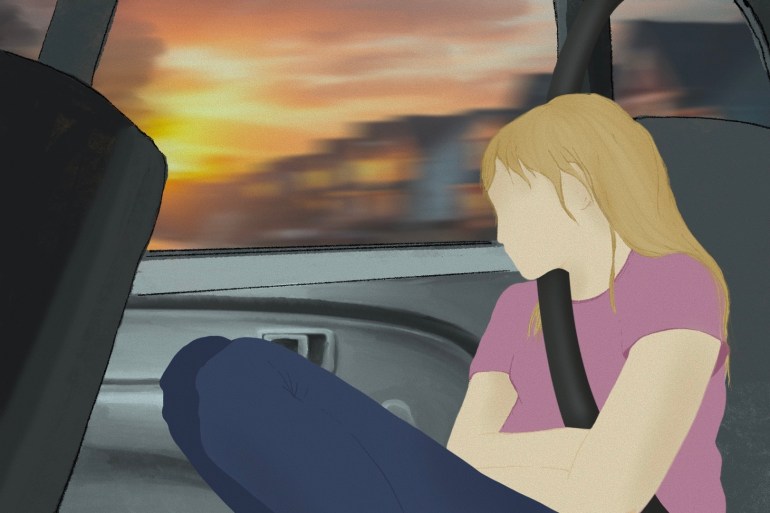When no one wants to listen: How being heard saved me from suicide
Warning: This story contains descriptions of suicide and references to child sexual abuse that some readers may find disturbing. If you or a loved one is experiencing suicidal thoughts, help and support are available. Visit Befrienders International for more information about support services.
I am 12 years old and standing in the shower. It is a Monday morning before school and I’ve turned the water temperature all the way up so it will scald my skin and burn any traces of the past weekend off my body and out of my memory. I am not just washing my hair; I am making a plan to end my life. I have four options in my mind. Each of them scares me. My mother knocks on the door, telling me to hurry or I’ll miss my bus. That startles me into action. I settle on my plan, turn the water off and feel relief flow down my spine.
According to a medical journal article published in April 2023, suicide is now the leading cause of death for 13-to-14-year-olds in the United States. When I was 12, I thought I was alone in considering such drastic action. No one I knew discussed suicide. It was not a topic that was ever brought up in school. But it was an idea that had lingered in my head for many months before that Monday morning shower.
It had taken root there a couple of years after my uncle started to molest me. I hadn’t told my parents because sexual abuse was another topic that was never discussed. I had never heard of it before, had never been warned. I didn’t even have language for what was happening to me. All I knew was that I had to implement my suicide plan before Friday, when we were due to visit his house again. I knew I could not let him touch me one more time; that I would do absolutely anything to prevent that.

The Bell Jar: I wasn’t alone
That Monday, as I walked through the school halls between classes, I saw my classmates at their lockers – laughing, joking, and talking about their weekends. I had friends. I enjoyed hanging out with them at lunch or at the park near our school in central New York State and at occasional sleepovers. As I watched them, I knew that I did not want to die; that I simply wanted my uncle to stop.
So, over the next couple of days, I created a Plan B. I told my mother that I had a babysitting job so I could stay home each weekend while my parents and three of my siblings drove the two hours to my uncle’s house. I spent the weekends inside alone, concerned that if I went out, my parents would discover my lie. I didn’t completely abandon the idea of suicide – I simply stored it away in my mind in case my babysitting story stopped working.
Eventually, I did find babysitting jobs, but when I wasn’t working, I listened to music and read The Lord of the Rings, finding consolation in other worlds. My personal theme song became Simon and Garfunkel’s I Am a Rock. Its lyrics – “I have my books and my poetry to protect me” – resonated deeply during those weekends. Then I discovered it – a paperback of Sylvia Plath’s semi-autobiographical novel The Bell Jar in our local convenience store. For the first time, I was hearing someone telling the story of why they might choose to kill themselves. The book made my cells vibrate. I knew I wasn’t alone. Someone else out there had felt what I was feeling.
The shame ate away at me
In the years that followed, it was always on my mind that I might somehow be forced back to my uncle’s house. I was forever vigilant, always prepared with an excuse to stay home, and I kept my backup plan ready, in case I needed to execute it.
An underlying anger permeated my emotions. I was angry at myself for “letting” it happen and angry at my parents for not being aware it had. I turned that anger inside.
I convinced myself that once I became an adult, life would be better. I had no way of knowing at that young age, that self-blame and anger can follow you.
By the age of 16, the world was looking a bit brighter. I was considering careers and other options, from joining the US Air Force to attending college. Writing in my secret diaries after the abuse began had become a healing outlet. I addressed my entries to “Dear World”. By now, looking around at the other girls and boys at school, I had realised that while I might have been the only one who had been molested, I wasn’t the only one who felt deeply sad.

Weighed down by sadness
Actual plans of suicide left me for almost two decades. It wasn’t until after I ended an eight-year relationship with an abusive man that I began to have suicidal thoughts again. At this point, I was living with my youngest brother who travelled a lot with his job. When he was away, I found myself isolated and lonely in a new part of the country. I had no money, no job and no energy to search for one. I slept on the living room couch, often all day and night, with the television on but the sound off and a CD player that rotated constantly through six albums. Because I had no health insurance or money, a friend suggested I visit a local state agency that offered free counselling. After several weeks, I finally agreed.
In our meeting, I explained to the counsellor that I wanted to paint my bedroom black and never emerge, that while I was at my lowest weight ever as an adult, I felt like I weighed 300 pounds (136kg), overloaded by the self-hatred and lethargy my sadness created. I blamed myself for the actions of my abuser who for years told me his violence was my fault. Instead of asking me questions or trying to understand my state of mind, she said it made no sense that I was feeling so down when I had finally left my abuser. I should be feeling “on top of the world”, she told me. I left and never returned. I went home, wrapped myself in a blanket and stayed on the couch for days.
When I couldn’t take the heaviness weighing on my body and my heart, I made another plan – just as I had that morning in the shower. I determined my method and visualised myself carrying it out. I was 35 years old and felt truly hopeless. At 16, it seemed that life could improve, but at 35, I felt too old to do the necessary emotional work to lift myself out of my depression. I knew I needed outside assistance, but just contemplating trying to find a counsellor who would understand and help me felt like a herculean task.
I had no desire to do anything. In fact, it was my lack of energy that saved me one night. I kept trying to push myself up off the couch to go to the next room and carry out my plan. But I couldn’t move. Years of grief and fear and guilt had built up inside me in thick layers that had hardened into rock. I was immobile that night. I shut out thoughts of my family and friends and imagined the peace I thought I would feel once dead. Before I fell asleep, I told myself that if I still felt the same way in the morning, I would get up and carry out my plan.

Someone who listened
Somehow, the next morning, a shard of hope entered my mind and I put my plan on hold. Day by day I considered taking the action, until one morning, I began calling counsellors and found one who agreed to work with me at a very low price. After our first session, I came home and wrapped myself in a Navajo blanket my brother had purchased in Santa Fe. I huddled in a ball and cried. This counsellor validated my emotions. She understood me. I felt the same way I had after reading The Bell Jar all those years earlier: I wasn’t alone. I knew I was going to be okay. I knew this woman would help me and she did. She listened carefully and with compassion and the more she did, the more I was able to stop hiding behind secrets and lies.
I realised my anger, guilt and hopelessness were intensified by the fact that, in addition to the physical and emotional abuse I had experienced at the hands of my abuser, I had yet to deal with the buried grief of childhood molestation.
In both instances, I blamed myself for the abuse; I felt I somehow deserved it. I told none of my family or friends because I believed they would blame me. I had no self-esteem. I had convinced myself ever since I was 11 that everything that happened to me was my fault.
Until I found the counsellor who would help me, I told no one of my plans or how deep and dark the depression I lived in was. No one in my world had any idea I was seriously considering taking my life. The world didn’t seem to want to know – no one around me ever mentioned suicide. My secrets had locked me into a cell of isolation once more.

He died alone
Three months ago, I learned that my most recent boyfriend had died by suicide. We hadn’t been in touch for a few years. When I ordered and received the death certificate in the mail and read the cause of death, I was deeply shocked. He was the last person I ever thought would take his own life. He was smart and funny and in the back of my mind, I always wanted to see him again. He lived to fly fish in small local streams, to hike the many mountains of Western Massachusetts. Like me, when I was younger, he found consolation in music and books and nature.
He was a loner, even in our relationship. He had no friends, just a couple of work acquaintances he didn’t interact with outside of the job. I knew when I left him he might be lonely. However, I assumed he would find another girlfriend and move on with his life.
He died alone in his house. It took three weeks for authorities to locate a relative to receive permission to dispose of the body.
When the initial shock of his death began to wear off, anger that he took his life rose in my throat. I stood above the Grand Canyon on a planned trip with my sister and screamed into the depths.
Since then I have been filled with a lingering sadness. For two months I read the death certificate over and over before bed each night. The reality wasn’t sinking in. I continue to struggle with “why”. I am left with questions that will never be answered, the many questions of “what if”.
Talking to others
We live in a world that largely doesn’t know how to speak of death in general and of suicide in particular. Discussions of suicide and depression can be very uncomfortable. But talking more openly about these subjects may be vital to allowing those considering the idea a chance to share their true feelings.
Many more children, young and older people are dying by suicide in the US.
Research shows that talking about suicide does not increase ideation or the risk of suicide, but can reduce it as well as the associated stigma and encourage people to seek help. Still, less than half of people thinking about suicide talk about it.
I could put on a good front when I was close to suicide. I didn’t lay on the couch all day sleeping when others were around. I hid my plans well.
In her book, Sylvia Plath explains that it is impossible to know if or when the bell jar will descend again. I don’t know if it will descend again for me. No one knows. What I have learned over the course of my life as I have dealt with my depression and suicidal thoughts is that by talking to others about my genuine emotions, despite how difficult that may be, I have felt less alone and have been able, with the assistance of counsellors and close friends, to find hope and purpose in staying alive.
A friend pointed out recently that the reason I am struggling so much with my former boyfriend’s suicide is that his death has forced me to see how my own suicide would have impacted my family and friends. When I was 12, and when I was 35, I could not think or imagine life beyond the moment of my death. I am on the other side now and I feel the hole of loss that my former boyfriend’s suicide has left. Nothing can fill it. But talking about it may be able to prevent it for others.
September is National Suicide Prevention Month in the United States.
Resources:
If you or someone you know is at risk of suicide, these organisations may be able to help:




